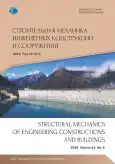Reliability and applicability of modern numerical analyses of dams
- 作者: Lyapichev Y.P.1, Mazza G.1,2, Mateu E.1, Zenz G.1,3, Carrère A.J1,4
-
隶属关系:
- International Commission on Large Dams
- Politecnico di Milano
- Graz University of Technology
- Tractebel Engineering SA, Le Delage
- 期: 卷 15, 编号 6 (2019)
- 页面: 458-469
- 栏目: Numerical methods of structures’ analysis
- URL: https://journal-vniispk.ru/1815-5235/article/view/346301
- DOI: https://doi.org/10.22363/1815-5235-2019-15-6-458-469
- ID: 346301
如何引用文章
全文:
详细
Relevance. At present the application of numerical analyses to real problems of dam engineering has suffered at times from the gaps between the specialists of mathematical modeling and dam engineers and managers. The first group usually includes information system specialists because they are able to develop the computer models to their full potential. The professionals belonging to the second group often prefer to revert to traditional methods of calculation and empirical methods based on their proven experience. The aim of the work - based on recommendations of International workshops seminars, organized by the ICOLD Committee on Computational Aspects of Dam Analysis and Design, help dam engineers to interact with mathematical modeling specialists and to work with them without language barriers or gaps in knowledge. In this relation the assessment of reliability and applicability of numerical analyses of dams allows engineers to develop the optimal dam design. Methods. Assessment of the reliability of numerical methods of analyses of dam behavior was based on data of 10 International benchmark-workshop seminars, organized by the Committee in Italy (1991 and 1992), France (1994 and 2009), Spain (1996), USA (1999), Austria (2001), Romania (2003), China (2005), Russia (2007), in which specialists of these countries also took part.
作者简介
Yury Lyapichev
International Commission on Large Dams
编辑信件的主要联系方式.
Email: lyapichev@mail.ru
Doctor of Technical Sciences, member of ICOLD Committee on Computational Aspects of Dam Analysis and Design Professor; Expert of JSC “Hydroproject Institute” for foreign projects
61 Avenue Kleber, Paris, 75016, French RepublicGuido Mazza
International Commission on Large Dams; Politecnico di Milano
Email: lyapichev@mail.ru
Doctor of Philosophy, Chairman of ICOLD Committee on Computational aspects of Dam Analysis and Design; Expert of Italian Center on Dam Safety
61 Avenue Kleber, Paris, 75016, French Republic; 32 Piazza Leonardo da Vinci, Milano, 20133, Italian RepublicEnrique Mateu
International Commission on Large Dams
Email: lyapichev@mail.ru
Doctor of Philosophy, member of ICOLD Committee on Computational Aspects of Dam Analysis and Design; Expert of U.S. Department of Homeland Security
61 Avenue Kleber, Paris, 75016, French RepublicGerald Zenz
International Commission on Large Dams; Graz University of Technology
Email: lyapichev@mail.ru
Doctor of Philosophy, Vice-Chairman of ICOLD Committee on Computational Aspects of Dam Analysis and Design; Head of Department of Management, Institute of Hydraulic Engineering and Water Resources Management
61 Avenue Kleber, Paris, 75016, French Republic; 12 Rechbauerstraße, Graz, 8010, Republic of AustriaAlain Carrère
International Commission on Large Dams; Tractebel Engineering SA, Le Delage
Email: lyapichev@mail.ru
Doctor of Philosophy, member of ICOLD Committee on Selection of Dam Type; Director (Science and Technology) of Coyne et Bellier (now - Tractebel Engineering)
61 Avenue Kleber, Paris, 75016, French Republic; 5 rue du 19 mars 1962, Gennevilliers Cedex, 92622, French Republic参考
- ICOLD Bulletin 155. (2013). Guidelines for use of numerical models in dam engineering. Paris.
- ICOLD Bulletin 122. (2001). Reliability and applicability of computational procedures for dam engineering. Paris.
- ICOLD Committee on Computational Aspects of Dam Analysis and Design. (1994-2009). 3-10th Intern. Workshop Seminars on Numerical Analysis for Dams: France1994, Spain-1996, USA-1999, Austria-2001, Romania2003, China-2005, Russia-2007, France-2009. Balkema Publ., Holland.
- Lyapichev Yu. (2001). Classification and selection of constitutive models of soils for embankment dam analysis. Appendix 2. ICOLD Bulletin 122 (pp. 135-138). Paris (France).
- Lyapichev Yu. (1994). Extensions of the modified Cam Clay models for modelling of compacted soil and rockfill materials of embankment dams. Stroitel'naya mekhanika inzhenernyh konstrukcij i sooruzhenij [Structural Mechanics of Engineering Constructions and Buildings]: interuniversity collection of scientific papers, 4, 86-110. (In Russ.)
- Carrere A., Mazza G. (2007). The Contribution in ICOLD Bull. 155 for Committee on Computational Aspects of Dam Analysis and Design. 5th Intern. Conference on Dam Engineering, Lisbon (Portugal).
- Carrere A., Zenz G., Mazza G. (2010). The contribution in ICOLD Bull. 155 for Committee on Computational Aspects of Dam Analysis and Design to the diffusion of the knowledge in the numerical modelling and to the transfer of know-how between generations. Symposium on dam safety - sustainability in a changing environment, 8th IECS2010, Innsbruck (Austria).
- Carrere A., Anthiniac P., Develay D. (2002). The contribution of numerical analysis to the design of CFRD. Hydropower and Dams, 9(4).
- Mazza G., Marcello A. (2003). Rehabilitation design of Molato dam. Proceedings of 21st International Congress on Large Dams Congress, Montreal (Canada). Q. 82, R. 3.
- Zenz G., Escuder I., Lombillo A. (2009). Risk analysis and probability of failure of gravity dam. Proceedings of 23rd International Congress on Large Dams, Saint Petersburg (Russia). Q. 91, R. 49.
- Mateu E., Tinawi, R. (2003). Transient damping and uplift pressure responses of cracked concrete gravity dams subjected to earthquakes. Proc. of 21st Intern. Congress on Large Dams, Montreal (Canada). Q. 83.
- Mateu E., Tinawi R., Leclerc M. (2000). Seismic safety of gravity dams: from shake table experiments to numerical analyses. ASCE Journal of Structural Engineering, 124(12), 518-529.
- Duncan M., Chang Y.Y. (1970, September). Nonlinear analysis of stress and strain in soils. Journal of Soil Mechanics and Foundation Division, ASCE, 96(SM5), 1629-1653.
- Roscoe K.H., Burland J.B. (1968). On the generalized stress-strain behavior of wet clay. In J. Heyman (ed.), Engineering Plasticity (pp. 535-609). Cambridge University Press.
- Lade P.V. (1977). Elastoplastic stress-strain theory for cohesionless soil with curved yield surfaces. Intern. Journal of Solids and Structures, 13, 1019-1035.
- Prevost J.H. (1978). Plasticity theory for soil stressstrain behaviour. Journal of Engineering Mechanics Division, ASCE, 104, 1174-1194.
- Zaretsky Yu. (1996). Soil viscoplasticity and design of structures. Balkema Publ., Holland.
补充文件









